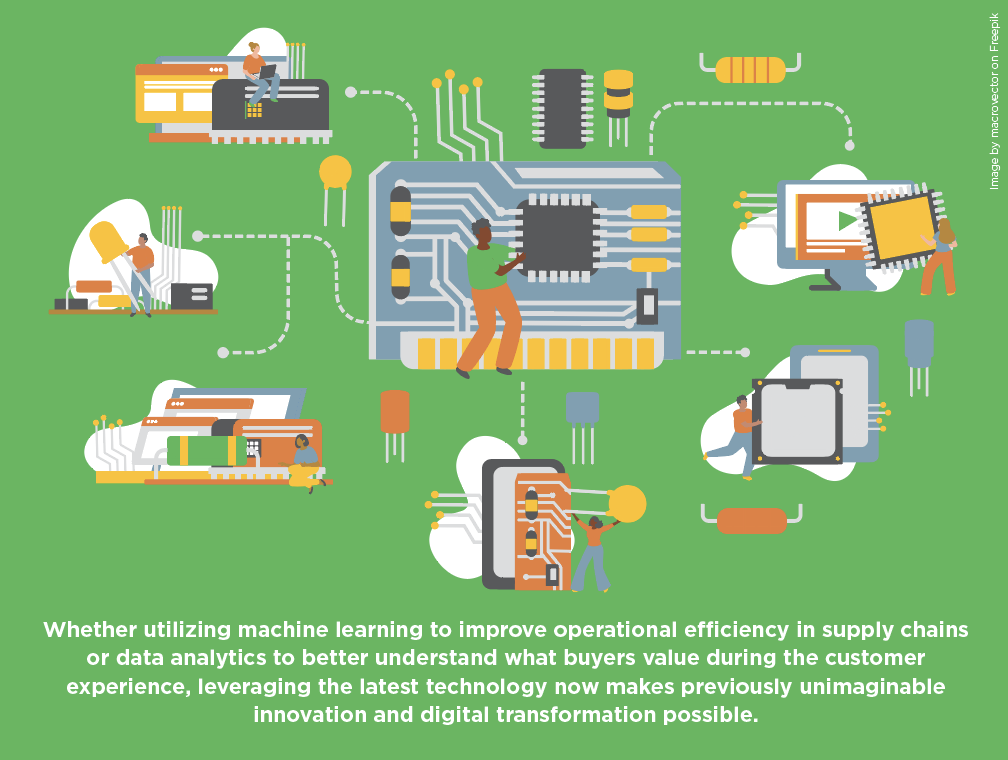While potentially disruptive digital technologies such as cloud computing, virtual reality, machine learning, and artificial intelligence (AI) have been around for a number of years, today they are finally capable of addressing real-world concerns for both consumers and business owners alike. It is little wonder why organizations worldwide are expected to spend more than $4.6 trillion on new digital technology in 2023, according to a report from Nash Squared. That is up from $4.2 trillion in 2021. Whether utilizing machine learning to improve operational efficiency in supply chains or data analytics to better understand what buyers value during the customer experience, leveraging the latest technology now makes previously unimaginable innovation and digital transformation possible. These technologies are particularly important in the high-tech industry where embracing digital technologies is paramount. Which high-tech trends will stand out and how will businesses be investing in the future throughout 2023? Here are a few possibilities:
High-Tech Trend No. 1: Workplace Automation
In the high-tech industry, organizations can gain speed and efficiency in 2023 and beyond by automating many of their routine and semi-routine processes. Workplace automation frees up time and energy for creativity and innovation by eliminating mundane business processes. While workplace automation can involve computers doing the work of a user, that is not the extent of their use. These automation tools can also be harnessed to create business value from contextual information. They help businesses respond with speed and urgency to changing markets and demands and also delegate tasks more effectively. This technology is crucial to the creation of more efficient and effective organizations.
Another example of the way high-tech organizations are automating the workplace is through ambient computing. Otherwise known as ubiquitous computing, ambient computing is a somewhat complex concept to grasp — quite literally. That is because the technology itself is invisible. Instead, it is embedded in the users’ surroundings. Imagine, for example, a thermostat that raises and lowers the temperature within a room by “remembering” or “learning” the habits of the homeowner. Or ponder the possibility of a smartphone that tells a driver how long it takes to get to a frequently visited destination just as he or she enters the vehicle. Ambient computing is what makes these capabilities possible; it is baked into daily life.
Jason Low, principal analyst for the research firm Canalys, told ZDNET that ambient computing is very similar conceptually to internet of things (IoT) technology, which relies on machine learning to perform predictive capabilities. But there is a key difference between the two. “IoT forms a base for ambient computing, with ambient computing more focused on how devices and intelligent services interact with users,” Low explained.
In essence, ambient computing is a more nuanced form of the Internet of Things that is centered on how IoT devices go about gathering data on users. Amazon, Google, Apple, and Microsoft are just a few of the major high-tech corporations that are either utilizing this latest technology trend in one of their consumer products (e.g., Alexa, Amazon’s Echo Device voice assistant) or seeking to expand its use through more IoT devices.
One way high-tech businesses are increasingly relying on ambient technology is by making it easier for staff to collaborate across different geographies. The pandemic was a game changer for the workplace. Due to state-mandated lockdowns, many organizations were forced to close their offices and conduct day-to-day business affairs entirely remotely. Given that work productivity often did not suffer — and in some cases actually improved — several workplaces now permit their employees to work 100% remotely. In fact, according to a recent Gallup poll, just 20% of “remote-capable” employees (those whose jobs can be done from home) work entirely on-site. Among those who have the ability to do their job from home and the workplace, 50% divide their time between the two.
But having staff in different environments can present communication challenges when work requires collaboration via video conferencing tools, such as having trouble hearing who is speaking. As ZDNET reported, more organizations are relying on ambient computing in their conference rooms to address these issues. When deployed, the technology can seamlessly amplify voices so those speaking can be more easily heard by colleagues who are working from home. Essentially, the technology allows individuals to sit anywhere they want and speak normally rather than need to sit near the computer or raise their voices. Ambient computing allows companies to work more efficiently and increases flexibility.
High-Tech Trend No. 2: Continuous Penetration Testing
Cybercrime has become so commonplace that it is only a matter of time before a business is impacted by an attack — if it has not already encountered one. Nearly all businesses, regardless of their size, are in hackers’ crosshairs. In fact, according to Check Point Research, there was a 28% increase in cyberattacks globally in the third quarter of 2022 compared with one year earlier. Ransomware, which involves hijacking or locking down an organization’s system or network until a ransom is paid, is one of the most common types of cyberattacks. The pervasiveness of these attacks — and their difficulty to deter — is why Cybersecurity Ventures anticipates victims will experience $265 billion in losses by 2031, with attacks occurring once every two seconds.
High-tech companies are often targeted by cybercriminals because of the vast array of information and data an attack can provide. Beyond traditional cybersecurity measures, such as investing in software and reminding workers to follow strict safety protocols, high-tech businesses are investing in continuous penetration testing to fight back. Unlike traditional penetration testing, which assesses the resilience of a network at a specific point in time, continuous penetration is ongoing. This is done by simulating regularly occurring attacks. According to Forbes, an increasing number of organizations are turning to continuous penetration testing as a way to blunt cyberattacks, in general, and ransomware attacks, in particular. Penetration testing can be a reliable strategy because it helps to identify vulnerabilities, improve cyber risk management, and automates security monitoring in real time rather than during one specific instance.
Leveraging automated security monitoring can also help lower high-tech businesses’ costs by eliminating the need to rely on internal staff or outside help. However, cybersecurity expertise is hard to come by. According to (ISC)2, the cybersecurity industry is in the midst of a severe shortfall in experienced professionals who can meet the demand for services. It is a global problem, too, with job openings worldwide increasing by 350% between 2013 and 2021, according to Secureworks.

High-Tech Trend No. 3: Augmented Reality
Augmented reality involves superimposing the digital world onto the real world by leveraging high-tech devices. Sony, Microsoft, Nintendo, and other video game developers all offer augmented reality products to boost the customer experience for avid gamers. But augmented reality is not found exclusively among the gaming community; it is also used by schools to enhance learning, by retailers to personalize online shopping, and by businesses to train employees. The emerging technology is expected to become even more omnipresent in 2023. In fact, Research and Markets estimates that the augmented reality market’s valuation will top $61 billion worldwide in 2023 and continue to rise from there. The high-tech industry will be one of the main beneficiaries of this emerging technology.
In high-tech manufacturing, for example, augmented reality allows companies to overcome the challenges posed by their contract manufacturers’ high turnover rates. Turnover often results in less efficient processes, more human errors, and lower productivity. One way it accomplishes this is by enabling real-time training that allows workers to visualize – rather than simply hear about – vital work instructions and processes as they perform their jobs.
Augmented reality also has the potential to significantly improve quality assurance initiatives during every stage of high-tech product development. Guided AR solutions, such as the use of 3D imagery and machine learning to simulate the workings of mechanical components, now allow manufacturers to identify and rectify potentially costly design errors before products roll off the factory floor. In addition, augmented reality can improve the data management and analytics outcomes unique to manual processes. Through process simulation and workflow tracking, high-tech manufacturers can gather and document important information about inefficient cycle times, designs, and operational metrics that might otherwise go unrecorded and unnoticed until a problem arises.
High-Tech Trend No. 4: Artificial Intelligence
As far back as 2018, 85% of Americans were using at least one product that had AI capabilities, according to a Gallup survey. Artificial intelligence, while still a relatively new technology, is in full bloom. Industry experts believe AI will continue to saturate the marketplace in 2023. One type of AI that is poised to become more prominent is no-code AI. As its name implies, no-code AI is a code-free technology that makes it easier for users to implement and test their ideas through drag-and-drop interfaces. The turn-key nature of drag and drop enables any business owner — regardless of their familiarity with AI — to take advantage of it without expert assistance.
An increasing number of high-tech companies are also using artificial intelligence as well as machine learning to strengthen their supply chains before disruptions occur. These technologies speed up time to remediation by automating product analysis. Edge computing, for example, puts the processing power of AI and ML closer to the devices they monitor. That embeds crucial insights deeper into every aspect of operations, making supply chains function more efficiently and cost-effective over the long term. AI also provides benefits after a successful product launch, such as the ability to leverage user data to enhance product-related software, customer service, and security. Many of the online campaigns and tools high-tech companies now use — think search engine strategies and chatbots — rely on AI to engage potential consumers searching for specific content online and then guide them to desired outcomes.
New technologies have long been the key agents of growth in a wide variety of industries — and will continue playing that role in the decades ahead. Yet it is safe to say that the speed and intensity of innovation, disruption, and competition in the high-tech industry are unrivaled by those in any other realm. By their very nature, research and development initiatives drive the success and profitability of high-tech enterprises, so the reliance on cutting-edge technology by manufacturers and R&D firms will only grow in the future.
Almost any high-tech organization will have opportunities to benefit from these technology trends in 2023 and beyond. At Inspirage, we offer transformational services that can help keep your business on track by bringing the right teams and technologies together to optimize agility and drive operational excellence. Contact us today to learn more or download our new high-tech eBook.
